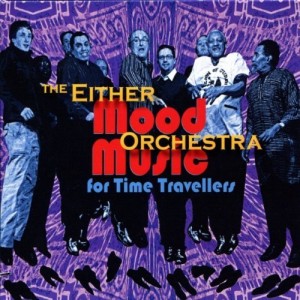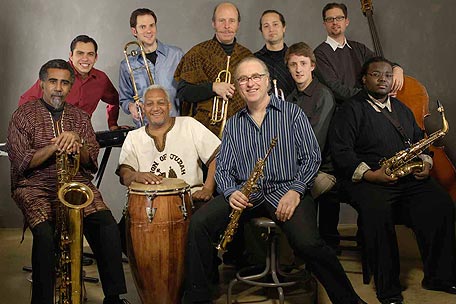Jazz Review: Either / Orchestra — (10 + X) 25 = E / O
The larger the band, the more important its leader.
The sheer drudgery of keeping a large jazz ensemble functioning as a musical and business entity leads almost inevitably to a need for a guiding intelligence. Even if one person isn’t personally booking the gigs, making the phone calls, preparing the lead sheets, organizing the rehearsals, writing the checks, and smoothing the ruffled feathers, the ultimate responsibility for all these things usually falls to one person. Even worse, the large jazz group is often a non-profit unincorporation whose hard-wrought product dissipates like smoke, preserved only in the memories of its listeners and in its own self-funded recordings.
Why would anyone bother with this, much less do it for 25 years? Russ Gershon answers with a simple, selfless reason: “The music still gasses me.”
Gershon’s 10-piece band, the Either / Orchestra (E / O), is a triumph of longevity. Unlike Mark Harvey’s Aardvark at MIT or the ensembles led by Bob Brookmeyer (1997–2007) and Ken Schaphorst at the New England Conservatory, or Greg Hopkins’s Berklee Concert Jazz Orchestra (advancing the work of such illustrious predecessors as Herb Pomeroy and Phil Wilson), the E / O has no academic base, no concert hall it can call home. There have been other nomadic big groups in Boston jazz history—Sabby Lewis’s swing orchestra, Baird Hersey’s Year of the Ear, the Harvey-Roditi Big Band, George Schuller’s Orange Then Blue, and many more now forgotten—but they couldn’t survive the comings and goings of star players, the deaths of congenial venues, and the endless onslaught of extra-musical variables.
(The Jazz Composers Alliance Orchestra, also celebrating its 25th anniversary this year, is a hydra of a very different color, and I’ll have an appreciation of their work in a few weeks.)
Despite its age, the Either / Orchestra exists more as a spiritual construct than a physical reality. More than 50 musicians have passed through its ranks, with trumpeter Tom Halter, percussionist Vicente Lebron, bassist Rick McLaughlin, trombonist Joel Yennior, and saxophonist Charlie Kohlhase among the very few who have held their chairs for more than a few years. The alumni—including saxophonists Miguel Zenon and Jaleel Shaw, drummer Matt Wilson, and keyboardist John Medeski—do not share a particular school or style of jazz.
The scores, mostly by Gershon but including contributions by many former and current members, along with arrangements of music by Monk, Ellington, Rollins, Horace Silver, Julius Hemphill, Bob Dylan, Lennon/McCartney, and Ethiopian songwriters, do not constitute a unified body of work. (Pick some random unidentified tracks from their first recording, Dial ‘E’, from their 2004 Live in Addis, and from their newest release, Mood Music for Time Travellers. You’ll have a hard time guessing that the same band is performing on all three.)
Consider yourself informed: on December 16, the Either / Orchestra will celebrate its 25th anniversary with a concert at the Regent Theater in Arlington. There will be alumni on hand as guest soloists, there will be Ethiopian music played brilliantly, there will be a lot of Latin excitement, and Russ Gershon will preside, as always, basking in the glow of the fire he’s tended so well and for so many years.
And yet. And yet. There is a unified aesthetic, a set of unspoken principles that animate Gershon’s own music, inspire his collaborators, and keep the band alive in the best sense of the word: a commitment to collective effort that allows just enough individual virtuosity, a devotion to strong melodic lines, a wry wit, a love of excitement and surprise, a genuine fellow-feeling on the bandstand, and feedback from audience regulars that makes performances feel something like family reunions.
Not the least of Gershon’s accomplishments is his gift for marketing. When I last wrote about the band (in the Boston Phoenix, in 1991), I pointed to his forward-thinking DIY approach: coming up with one of the cleverest and most memorable names for a group I’d ever heard; starting his own record label and giving it another clever handle (Accurate Records); and most importantly, assiduously nurturing the band’s mailing list and cultivating its audience—something that was not uncommon at the time, but marked a significant departure for a jazz group.
The strategy worked then. Over time it turned the band’s interested listeners into a cheering section. And now it works more effectively than ever, with electronic augmentation provided by a chatty website, Facebook and Myspace pages, and plenty of cross-promotion from like-minded souls across the net. When the Either / Orchestra played the Regattabar on September 11, the place was packed, despite only the most minimal hype in the MSM.
With two exceptions, the edition of the band heard at the Regatta was the same as that on Mood Music for Time Travellers, and most of the music was drawn from that new release. Hailey Niswanger, the newest member of the group, filled the alto and flute roles previously assigned to Godwin Louis and Henry Cook, and Nick Catino, who’s also been heard with Mariachi Palenque, took Daniel Rosenthal’s position as second trumpet.
Those who have followed the band throughout its history know that it first explored an idiosyncratic version of straight-ahead jazz in mid-size incarnations (Gershon cites music made by Tadd Dameron, Charles Mingus, and Sun Ra among its influences). In 1996, Gershon reformed the group following a six-month hiatus, and world music took a more important place in the repertoire, culminating in a love affair with traditional and contemporary Ethiopian popular songs that added a rich new dimension to the band’s book. With the arrival of drummer Pablo Bencid and pianist Rafael Alcala to provide more salsa atop Vicente Lebron’s congas and bongos, Gershon is currently enjoying more than a tinge of Latin music. The 2010 version of the E / O doesn’t exactly break with the past, but it certainly steps in a new direction.
Everything about the Regatta performance showed the players’ assurance and comfort with the new tunes, some of which have evolved a bit from the versions heard on Time Travellers. “The (One of a Kind) Shimmy,” for example, had a somewhat brighter tempo that brought its Blue-Note-boogaloo roots closer to the surface. “Beaucoups Kookoo” was re-shaped by adding a fiery Alcala solo and an extensive feature for bassist Rick McLaughlin. And trombonist Yennior’s Eddie Palmieri-ish “Latin Dimensions” was even more Latin than it is on the CD, with the bassist setting aside his main axe to add a strong clave under a Lebron-Bencid percussion discussion.
Some older repertoire appeared as well. It wouldn’t be an E / O show without something Ethiopian, so they played Afèwèrq Johannes’s “Altchalkoum,” with a very affecting Gershon tenor saxophone solo, so beautifully integrated that the audience chose not to break its mood and held applause as the band went back into the head.
One big highlight of the night was a revisiting of Bob Nieske’s “Fast Edd,” recorded on the E / O’s Neo-Modernism CD (Accurate, 2003). Hailey Niswanger, who had strong solos all night long, tore this sucker up, only to be upstaged by Kohlhase and guest Kurtis Rivers, who bobbed and weaved through an unaccompanied two-baritone duet, throwing the lead back and forth as deftly as two Flying Karamazov Brothers.
Even if you’ve had the pleasure of hearing the band recently, the new CD is well worth your attention. Among my favorite new pieces are Gershon’s groove tune “The Petrograd Revision,” which adds some nice tone colors to the band’s palette with a Hammond B-3; McLaughlin’s “Thirty Five,” with a very nice Alcala solo; and Yennior’s tune “Suriname,” a Caribbean-style outing in 13/4, which the band handles effortlessly. If I had been mixing, I would have brought the traps up just a bit, but that’s a very minor quibble. There’s a lot to like here.
Mood Music for Time Travellers. Either / Orchestra
(Accurate CD; $15.99 via Amazon, $14.19 via CD Universe, $13.99 via Tower.com, $13.19 via allegro-music.com, $12.08 via bn.com, $16 [incl. shipping] through the website.




What a splendid historical overview and lively, present-day review of one of Boston’s most illustrious and grittiest bands!
Great article, Steve. Thanks for the coverage!
I disagree, however, with your contention that the E/O “exists more as a spiritual construct than a physical reality.” The E/O is a working band, even though we don’t tour as much as we used to. It has a set lineup, regular rehearsals, and a collective agenda.
It is ALSO a spiritual construct for its members, former members, fans, collaborators, and past presenters, and I take that as a compliment.
However, the E/O is not an ethereal idea, but a day-to-day operation.